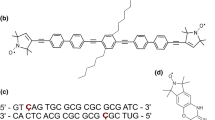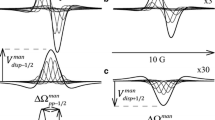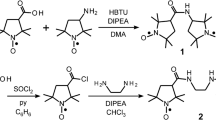Abstract
The double-quantum-coherence (DQC) echo signal for two coupled nitroxides separated by distances ≳10 Å, is calculated rigorously for the six-pulse sequence. Successive application of six pulses on the initial density matrix, with appropriate inter-pulse time evolution and coherence pathway selection leaves only the coherent pathways of interest. The amplitude of the echo signal following the last π pulse can be used to obtain a one-dimensional (1D) dipolar spectrum (Pake doublet), and the echo envelope can be used to construct the 2D DQC spectrum. The calculations are carried out using the product space spanned by the two electron-spin magnetic quantum numbers m 1, m 2 and the two nuclear-spin magnetic quantum numbers M 1, M 2, describing, e.g. two coupled nitroxides in bilabeled proteins. The density matrix is subjected to a cascade of unitary transformations taking into account dipolar and electron exchange interactions during each pulse and during the evolution in the absence of a pulse. The unitary transformations use the eigensystem of the effective spin Hamiltonians obtained by numerical matrix diagonalization. Simulations are carried out for a range of dipolar interactions, D, and microwave magnetic field strength B 1 for both fixed and random orientations of the two 14N (and 15N) nitroxides. Relaxation effects were not included. Several examples of 1D and 2D Fourier transforms of the time-domain signals versus dipolar evolution and spin-echo envelope time variables are shown for illustration. Comparisons are made between 1D rigorous simulations and analytical approximations. The rigorous simulations presented here provide insights into DQC electron spin resonance spectroscopy, they serve as a standard to evaluate the results of approximate theories, and they can be employed to plan future DQC experiments.










Similar content being viewed by others
References
S. Saxena, J.H. Freed, J. Chem. Phys. 107, 1317–1340 (1997)
P. Borbat, J.H. Freed, in Biological Magnetic Resonance, vol. 19, ed. by L.J. Berliner, S.S. Eaton, G.R. Eaton (Kluwer/Plenum Publications, New York, 2000), pp. 383–459
P.P. Borbat, J.H. Freed, Chem. Phys. Lett. 313, 145–154 (1999)
P.P. Borbat, J.H. Freed, Methods Enzymol. 423, 52–116 (2007)
P.P. Borbat, J.H. Freed, EPR Newsl. 17(2–3), 21–29 (2007)
S. Lee, D.E. Budil, J.H. Freed, J. Chem. Phys. 101, 5529–5558 (1994)
M. Suzuki, J. Math. Phys. 26, 601–612 (1985)
H.F. Trotter, Am. Math. Soc. 10, 545–551 (1959)
R.R. Ernst, G. Bodenhausen, A. Wokaun, Principles of Nuclear Magnetic Resonance in One and Two Dimensions (Clarendon Press, Oxford, 1987)
C. Gemperle, G. Aebli, A. Schweiger, R.R. Ernst, J. Magn. Reson. 88, 241–256 (1990)
S.K. Misra, V. Vasilopoulos, J. Phys. C Condens. Matter 13, 1083–1092 (1983)
T.Y. Li, R.H. Rhee, Numer. Methods 55, 83 (1989)
M. Oettli, Technical Report 205, Department Informatik, ETH, Zurich (1993)
K.E. Gates, M. Griffin, G.R. Hanson, K. Burrage, J. Magn. Reson. 135, 103–112 (1998)
S.K. Misra, J. Magn. Reson. 140, 83–92 (1999)
S.K. Misra, J. Appl. Glob. Res. 2, 38–45 (2009)
S.Y. Lee, B.R. Patyal, J.H. Freed, J. Chem. Phys. 98, 3665–3689 (1993)
J.H. Freed, in Spin Labeling: Theory and Application, chap. 3, ed. by L.J. Berliner (Academic, New York, 1976)
D.J. Schneider, J.H. Freed, in Advances in Chemical Physics, vol. LXXIII, ed. by J.O. Hirschfelder, R.E. Wyatt, R.D. Coalson (Wiley, New York, 1989)
S.K. Misra, J. Magn. Reson. 189, 59–77 (2007)
L.J. Libertini, O.H. Griffith, J. Chem. Phys. 53, 1359–1367 (1970)
W.H. Press, S.A. Teukolsky, W.T. Vetterling, B.P. Flannery, Numerical Recipes in Fortran, 2nd edn. (Cambridge University Press, London, 1992), pp. 456–462
Acknowledgments
The authors are thankful to Ralph “Barry” Robinson for the help with building parallel code and to Dr. Richard H. Crepeau for useful advice. Access to Cornell University Theory Center is greatly acknowledged. This research was supported by NSERC, Canada and NIH/NCRR Grant P41RR016292, USA.
Author information
Authors and Affiliations
Corresponding authors
Appendices
Appendix 1: Nitroxide Spin Hamiltonian
The Zeeman and hyperfine part of the nitroxide spin Hamiltonian, H 0, in the irreducible spherical tensor operator (ISTO) representation takes the form [18–20]:
where L is the tensor rank (0 or 2); M = −L, …, L; k = 1, 2 numbers the nitroxides; and \({\ell }\) denotes the reference frame where the tensors are defined, i.e. magnetic frame (g k ), molecular (dipolar) frame (d), or laboratory frame (l). \( A_{{\mu_{k} ,\ell }}^{L,M} \) are the spin operators with μ k referring to the kind of magnetic interaction, electron Zeeman (g), nuclear Zeeman (N), or hyperfine (A), and they are usually defined in the laboratory frame; \( F_{{\mu_{j} ,\ell }}^{L,M} \) is proportional to the ISTO of the magnetic interaction and is most conveniently defined in the g-frame. The transformation of \( F_{{\mu_{k} ,g_{k} }}^{L,M} \) to the laboratory frame yields the H 0. In the high-field limit, where the non-secular terms (\( S_{ \pm } ,S_{ \pm } I_{z} ,S_{ \pm } I_{ \pm } ,S_{ \pm } I_{ \mp } \)) can be omitted, the ISTO form of the g-tensor reduces to:
Similarly, the relevant components of the hyperfine tensor are:
Also, the nuclear Zeeman term (when retained) is given by \( \sum\limits_{k} {F_{{N_{k} ,l}}^{0,0} A_{{N_{k} ,l}}^{0,0} } \) with
It is noted that the nuclear quadrupole term for 14N nitroxide is neglected. The second-rank tensors \( F_{{\mu ,g_{k} }}^{2,M} \) are transformed in two steps: first, from the kth nitroxide g-tensor axes to the dipolar frame, with its z-axis coincident with the vector r connecting magnetic dipoles, and then to the laboratory frame. The transformations from the dipolar frame to g-frame are defined by the Euler angles \( \lambda_{k} \equiv (\alpha {}_{k},\beta_{k} ,\gamma_{k} ) \, \) as shown in Fig. 2 and the transformation from the laboratory frame to the dipolar frame is defined by \( \eta \equiv (0,\theta ,\varphi ) \). The transformed tensors thus can be written as:
The Hamiltonian in the laboratory frame takes the form:
The coefficients C k , A k , G k , and B k are expressed as follows:
where
includes the transformations \( D_{{m^{\prime},m^{\prime\prime}}}^{2} \left( {\lambda_{k} } \right) \) from the dipolar frame to the kth magnetic frame. Since all the transformations were carried out numerically, the explicit expressions for C k , A k , and B k were unnecessary. They are somewhat lengthy and the reader is referred to Saxena and Freed [1]. We just mention that the terms C k , A k , and B k contain all anisotropies in the g and hyperfine tensors as well as the Euler angles needed for their transformation from the respective principal-axes system to the laboratory frame. It is also noted that C k , G k , and A k are real, whereas B k is complex. Finally, it is noted that in carrying out the computations for B 0 well up to Q-band (35 GHz), the nuclear Zeeman term can be safely omitted and the H 0 in real form can be obtained to a high accuracy based on the useful approximation described in Ref. [21].
Appendix 2: Algorithm to Calculate Six-Pulse DQC Echo Signal
This appendix contains the details of how to calculate the final density matrix, ρ f , from which the DQC echo signal can be calculated as given by Eqs. 14 and 15 below. Basically, this consists of carrying out a series of transformations of the density matrix by a propagator, pulse or free evolution, and choosing the matrix elements of the density matrix after the application of a pulse on a coherence pathway. Here, the direct-product representation for \( S_{1} \otimes S_{2} \otimes I_{1} \otimes I_{2} \) to write the matrix elements of the various operators involved in the calculation will be used. To this end, the following details are required.
2.1 Matrix Representation and Notation
For each electron with spin S = 1/2, the matrix dimension is 2, whereas for each nucleus with spin I, it is (2I + 1). Therefore, for the electron–nuclear-spin coupled system of the nitroxide pair the size of the product space is N × N with N = 4(2I 1 + 1)(2I 2 + 1), which for 14N nitroxides is 36 × 36. The Zeeman basis with the basis vectors \( \left| k \right\rangle \equiv \left| {m_{1} ,m_{2} ;M_{1} ,M_{2} } \right\rangle \) is used, where \( \left| k \right\rangle \)s are the eigenvectors of the z-components of the electron and nuclear-spin operators: \( S_{z} \left| m \right\rangle = m\left| m \right\rangle^{{}} \) and \( I_{z} \left| M \right\rangle = M\left| M \right\rangle \). Here m and M are the electronic and nuclear-spin magnetic quantum numbers, respectively. Lower-case Roman letters will be used to describe the basis state in the product space, Greek letters will be used to describe the eigenvectors of H: \( H\left| \alpha \right\rangle = \omega_{\alpha } \left| \alpha \right\rangle \). The Hamiltonian H is diagonalized by the unitary transformation V † HV = E, where E is a diagonal matrix of eigenvalues of H and V † is Hermitian adjoint of V. The columns of V are the eigenvectors of H: \( \left| \alpha \right\rangle_{k} = \left\langle {k} \mathrel{\left | {\vphantom {k \alpha }} \right. \kern-\nulldelimiterspace} {\alpha } \right\rangle \equiv V_{k\alpha } \). In the computations the matrices E and V are the outputs of the matrix diagonalization subroutine, such as JACOBI [22], used here. (A better version of the JACOBI subroutine than that given in [22] can be found on the Netlib website http://netlib.org or is available from the authors.)
2.2 Initial Density Matrix in Product Space
Using the expression for \( \rho (0)\) as given by Eq. 2, the initial density matrix is expressed as
where \( {\mathbf{1}}_{{I_{1} }} \) and \( {\mathbf{1}}_{{I_{2} }} \) are 3 × 3 unit matrices in the respective nuclear-spin spaces for 14N nitroxides. A diagonal matrix of order 4 × 4 on the right-hand side of Eq. 12 represents S z ≡ S 1z + S 2z in the product space \( S_{1} \otimes S_{2} \) for the two nitroxide electron spins, that is \( ({\varvec{\upsigma}}_{z} \otimes {\mathbf{1}}_{2} + {\mathbf{1}}_{1} \otimes {\varvec{\upsigma}}_{z} )/2 = {\text{diag(1,0,0,}} - 1 ) \), where 1 1 and 1 2 are 2 × 2 unit matrices in the spin spaces for electrons 1 and 2, respectively.
2.3 Transformation of the Density Matrix by a Propagator
The propagators to be considered here are either a pulse propagator due to a π/2 or a π pulse, or a free-evolution operator in the absence of a pulse. The effects of the various propagators as shown in Fig. 1 are calculated using Eq. 14 below, with the appropriate Hamiltonians and their durations. The procedure for a given density matrix, ρ, and Hamiltonian, H, acting during the time period, t, is described here, which can be specialized for the various propagators by appropriate substitutions, using appropriate times t k (t 1,2 = t p ; t 3,4 = t DQ; t 5 = t m - t p ; t 6 = t 5 + t echo) and Eqs. 6–10, which describe the Hamiltonians used in the analysis of the six-pulse DQC sequence. The transformed density matrix, ρ′, under the action of a propagator is expressed as:
Since \( {\text{e}}^{{ - iH_{km} t}} = V_{k\alpha } {\text{e}}^{{ - i\omega_{\alpha } t}} V_{\alpha m}^{*} \) the matrix elements of ρ′ in Eq. 13 can be expressed as \( \rho_{jk}^{\prime } = {\text{e}}^{{ - iH_{jm} t}} \rho_{mn} {\text{e}}^{{iH_{nk} t}} = V_{j\alpha } {\text{e}}^{{ - i\omega_{\alpha } t}} V_{m\alpha }^{*} \rho_{mn} V_{n\beta } {\text{e}}^{{ - i\omega_{\beta } t}} V_{k\beta }^{*} \), where summation is conducted over the repeating indexes, or explicitly
with \( \omega_{\alpha \beta } \equiv \omega_{\alpha } - \omega_{\beta } \). Equation (14) can be written using a short-hand notation as \( \rho^{\prime} = {\mathbf{L}}\rho . \) In this notation L is an operator, which is Q for a free-evolution period or R for the action of a pulse. Coherence pathway selection implies retaining only those elements of ρ′, which belong to the pathways of interest, with the subsequent summation conducted over all pathways that contribute to the echo of interest. In computations this is accomplished by retaining only those matrix elements that correspond to the selected pathway, setting the rest to zero. This may be expressed as the application of a projection operator P (which in reality does not need to be constructed). The final density matrix after application of N pulses and subsequent evolution periods is then calculated as
The product is computed for the full set of coherence pathways {p k } that contribute to the echo and the sum is then taken to be finally used in computing of \( Tr[\rho_{f} S_{ + } ]. \)
2.4 Coherence Pathway Selection
Subsequent to the action of a pulse propagator of the matrix elements, as calculated in (3) above, all but those in the electronic product subspace of the density matrix ρ that correspond to selected coherence order p should be set to zero. The correspondence of ρ ik to p is compiled in Table 1 pertinent to the coherence pathways depicted in Fig. 1 illustrating the coherence pathways of the six-pulse DQC sequence. This selection of coherence pathways is achieved experimentally through phase cycling [2] or in computations is based on Table 1.
Appendix 3: Calculating 1D DQC Signal using Approximate Expressions
Here, we include for completeness the equation from Ref. [2] that was used in this work for making the comparison with 1D DQC signals produced in rigorous computations. The echo amplitude, V, is a function of t dip = 2t p − t m and is given by
The time variables are defined in accordance with Fig. 1 and notations in the text. F(t) has the form:
Here A = d(1 − 3cos2 θ) and b = −A/2 represent the secular and pseudosecular parts of the dipolar coupling; R 2 = Δω 2 + b 2, where Δω = ω 1 − ω 2 is the difference between the Larmor frequencies ω 1 and ω 2 of the nitroxide’s electron spins in the frame of reference rotating with the frequency ω rf of the excitation pulses, which was set to coincide with the center of the nitroxide ESR spectrum. Also, q = b/R and p 2 = 1 – q 2. The amplitude factors were taken in the simplest possible form as
where ω 1rf = γ e B 1 for π pulses, which are taken equal here, but do not have to be.
Since ω k = ω k (λ k ,η), the powder averaging is conducted essentially in the same way as in rigorous computations with ω k determined for each set of (M 1, M 2). This was accomplished using an approximation [21].
Rights and permissions
About this article
Cite this article
Misra, S.K., Borbat, P.P. & Freed, J.H. Calculation of Double-Quantum-Coherence Two-dimensional Spectra: Distance Measurements and Orientational Correlations. Appl Magn Reson 36, 237–258 (2009). https://doi.org/10.1007/s00723-009-0023-5
Received:
Published:
Issue Date:
DOI: https://doi.org/10.1007/s00723-009-0023-5




